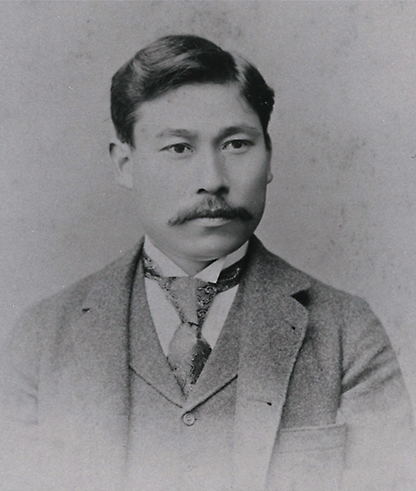Our Roots A history of rising to the challenge vol.16
Hisaya Iwasaki: The Humble Leader Who Never Forgot His Roots
We focus on Hisaya Iwasaki, Mitsubishi's third president, and how he was influenced by the teachings of his grandmother.

Hisaya Iwasaki, the eldest son of Mitsubishi founder Yataro Iwasaki , was born in 1865. Hisaya's grandmother, Miwa, was instrumental in shaping the values of the Iwasaki family and her teachings were also passed on to Hisaya through his mother, Kise.
When Hisaya was eight years old, the family moved to Osaka to join Yataro, who had established Mitsubishi Shokai as a marine transport company. When they arrived at their new residence, the previous occupants had not finished packing, but young workers from Mitsubishi Shokai proceeded to carry in the Iwasaki family's belongings, effectively displacing the previous residents. Hisaya was deeply troubled by this scene and he carried the memory with him throughout his lifetime.
The next year, Yataro moved on to Tokyo. His family also made the trip to Tokyo, arriving after 12 days on the road. Impressed by the way Hisaya walked during the long journey, Miwa concluded: "This boy is destined to achieve great things."
In Tokyo, Hisaya studied at Keio Gijuku (the precursor to today's Keio University) and later transferred to the Mitsubishi Commercial School, where he learned various subjects from English texts. In 1886, Hisaya departed for the U.S. to further his education on the recommendation of his uncle Yanosuke, who had become Mitsubishi's president following Yataro's death the previous year.
After arriving in Philadelphia, Hisaya stayed at a boarding house, like other students, and began studying English. He later entered the Wharton School of the University of Pennsylvania. During that time, Hisaya developed a close friendship with Lloyd Carpenter Griscom, who later served as the U.S. Minister to Japan. After graduation, the two friends traveled together in Europe. On the voyage across the Atlantic, Griscom went first class while Hisaya traveled third class. Griscom didn't learn about his friend's prominent background until the pair visited Russia toward the end of their trip. Hisaya must have received many presents from wealthy acquaintances in Japan before departing for the U.S., because he ordered large quantities of expensive furs in St. Petersburg to take home with him as gifts. An astonished Griscom later remarked: "Hisaya was someone of extremely high social standing, like Carnegie and Rockefeller combined, but I had no inkling of this until that moment."
Included among the family precepts articulated by Hisaya's grandmother was "do not forget the person you were when you were poor." As such, the importance of remembering one's roots was firmly implanted in the minds of Mitsubishi's first four presidents. Hisaya remained humble and grounded, even after becoming president of a giant conglomerate during a period of great prosperity, and throughout his tenure, he proved to be a business leader who was always considerate of others.
Hisaya & Kayacho
After the Great Kanto Earthquake and during the air raids of World War II, Hisaya provided shelter and meals for displaced people at his Kayacho estate in Tokyo. When incendiary bombs fell near the estate one day, one of Hisaya's grandchildren tried to lead him to an air-raid shelter, but Hisaya responded sharply, "How can we take refuge when everyone is working to put out the fire?" After the war, Kayacho was requisitioned by the occupying forces and the Iwasaki family was relegated to a corner of the Japanese residence. In 1948, the family moved to Suehiro Farm in Chiba Prefecture. As they prepared to depart Kayacho, Hisaya recalled how his family's arrival at its new residence in Osaka in 1873 had effectively displaced the previous occupants. "This time, the situation is reversed," he thought.
Kayacho was later used as a legal training and research institute, and today, the estate is open to the public as Kyu-Iwasaki-tei Gardens.